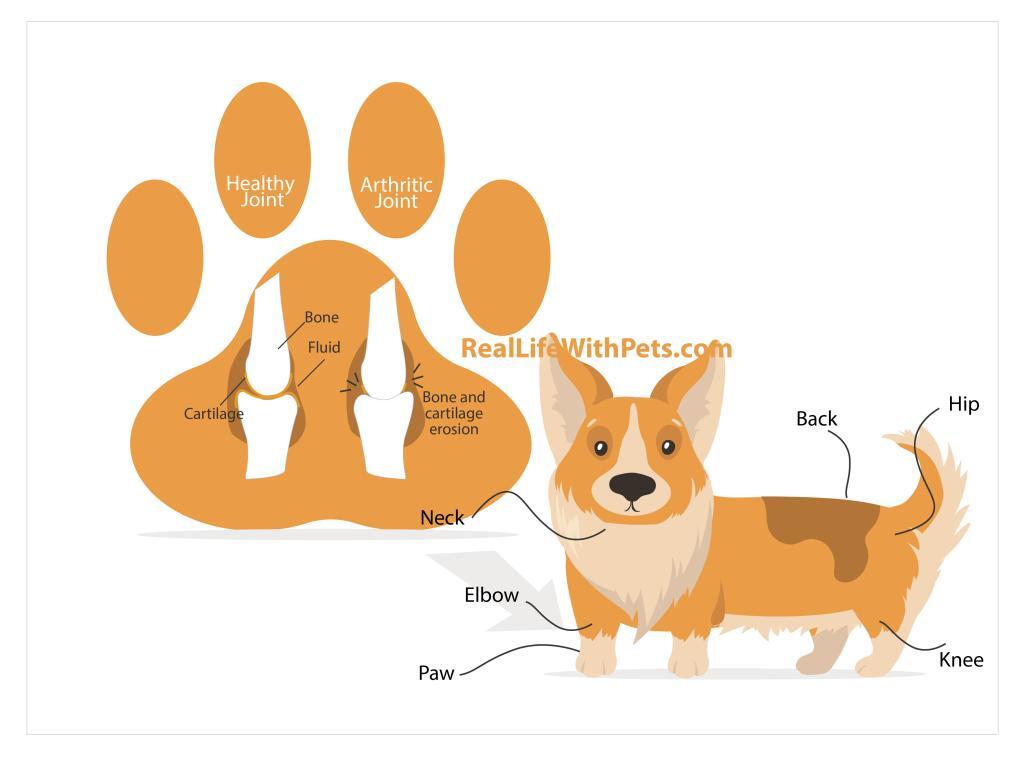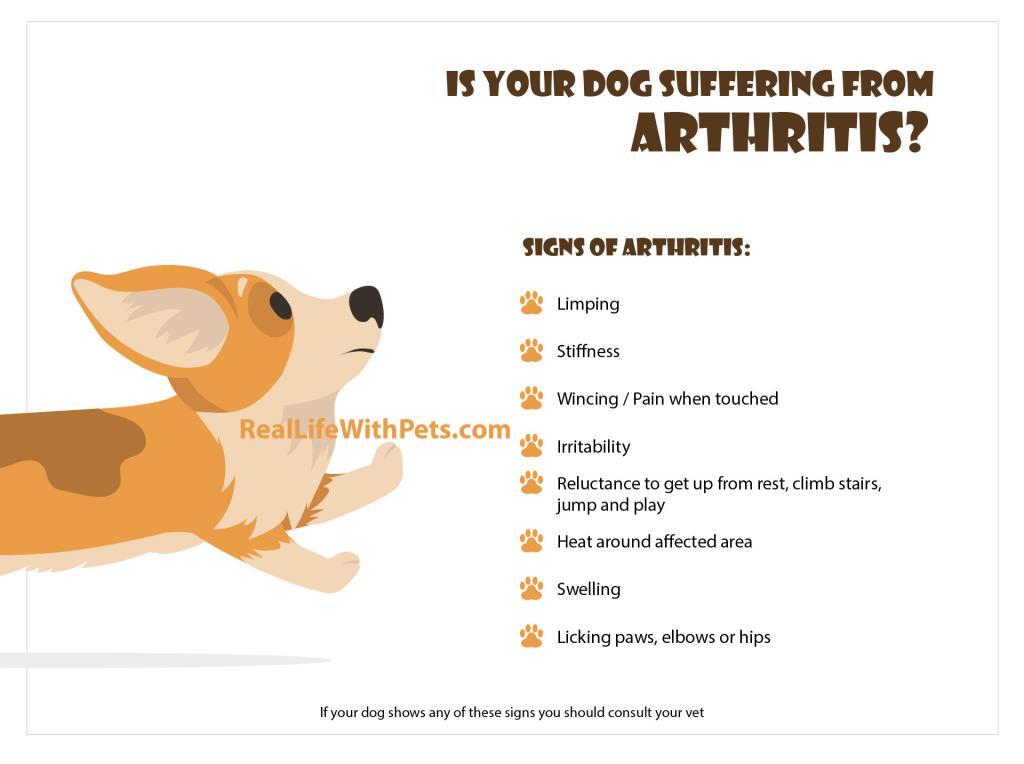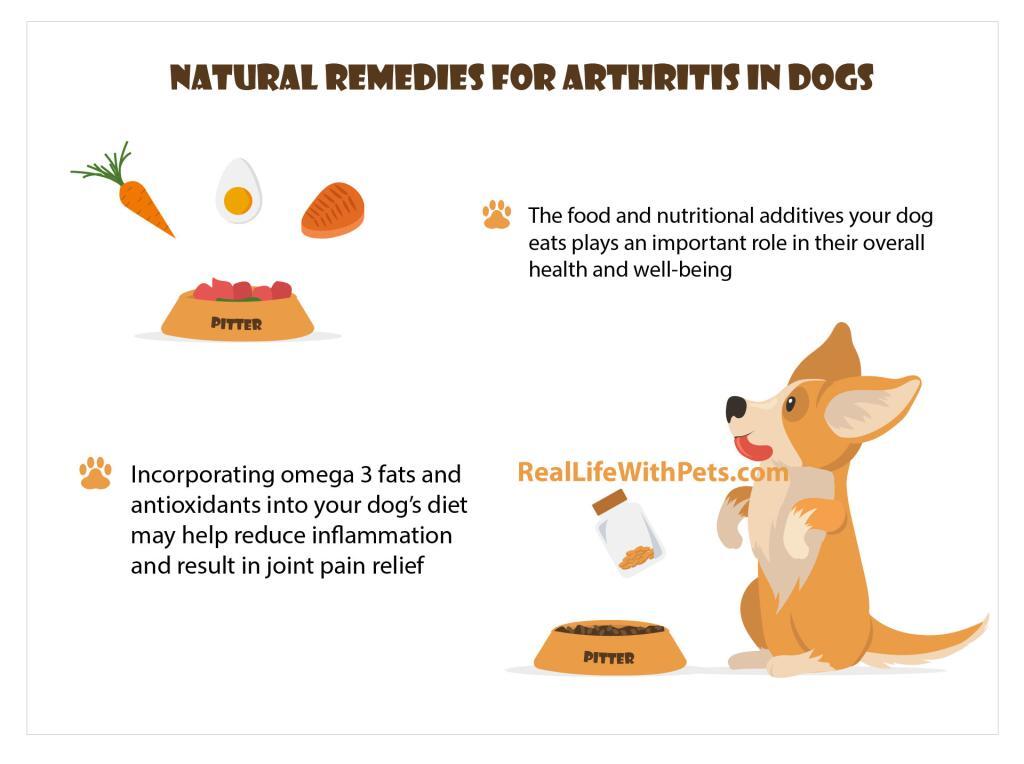Table of Contents
In most countries and nations, dogs are considered a symbol of joy and energy. These active animals give people a lot of positive emotions and charge them with their cheerfulness. But unfortunately, our pets – just like humans – are susceptible to various diseases. One of the most common and serious conditions is arthritis in dogs. Not only does this disease cause discomfort and stiffness, but it also has discouraging predictions. According to statistics, most cases of arthritis are incurable and eventually become chronic. It affects every fourth dog under age five and every third animal after 7.
Arthritis in Dogs
Arthritis in dogs is an inflammatory joint disease. It causes pain, discomfort, and even high temperature. In dogs with arthritis, cartilage within a joint (hip, elbow, etc.) changes or becomes damaged, making it less smooth and causing the bones in the joint to rub together. This rubbing can be uncomfortable or painful and can damage cartilage even more. Due to this increased friction, new bone forms around the joint, making it stiffer and more difficult to move (known as a degenerative joint disease).
Unlike other pets, like cats, dogs are the ones who are likely to get this unpleasant disease. A dog that suffers from arthritis moves slowly, trying not to injure the joints. The muscles are also in danger of dystrophy.

Causes of Arthritis in Dogs
Arthritis is usually an older dog’s problem. But the condition can develop from an early age due to bone and joint development problems. Depending on the cause, arthritis may affect one or more joints. Most cases develop as a result of abnormal rubbing within the joint caused by:
- joint instability (e.g., after ligament damage);
- damage caused by trauma (e.g., fractures);
- damage to or abnormal cartilage development.
Other causes of arthritis are:
- The age of a pet. In most cases, signs of arthritis in dogs appear when an animal is already 5-7 years or older. Eventually, joints become less moveable and lose their natural elasticity.
- An unbalanced diet often leads to obesity and weight gain. Accordingly, there is additional pressure on joints, which is the reason for their premature deterioration.
- Previous disorders. Joint injuries, infections, and viral diseases of the musculoskeletal system often precede the development of arthritis in dogs.
- The wrong choice of clothes for a pet in a cold season, sleeping in a draft, and swimming in cold water can cause arthritis.
Symptoms
One of the first common symptoms of the disease is the decreased activity of the animal. The pet becomes lethargic and refuses to go for long walks. Instead, they lie on the ground and rest a lot. The dog may change in personality (aggression when usually good-natured). They may lick the affected joints.
Another common sign of arthritis in dogs is swelling in a joint and painfulness when pressing on it. The animal tries not to use the sick paw when walking. Instead, it carefully steps on it or flexes it. It becomes tough for the pet to flex and extend the paw.

If the joints of the forelimbs are affected, the dog may refuse to go downstairs or upstairs. With pain in the leg, it is difficult for a pet to go down the hill or climb a high sofa or a chair. As arthritis in dogs progresses, symptoms worsen, or new ones appear.
In the severe form of the disease, the disorder develops quickly (within a few hours or days). The symptoms get worse, and the dog’s condition differs between yesterday and today. In chronic arthritis, symptoms deteriorate gradually, and the overall illness patterns remain hidden for a long time. Often this misleads the owners, who associate this condition with the pet’s age or a change in their habits.
How Are Dogs Diagnosed with Arthritis?
Your vet can sometimes tell which joints are affected by any pain and/or discomfort by examination, including joint extension and flexion. Then, they may suggest further tests (e.g., x-rays) to investigate appropriately, confirm and locate arthritic change, and sometimes identify any underlying causes. In some cases, blood samples may be needed to rule out any medical conditions associated with arthritis.
Home Remedies and Treatment for Arthritis in Dogs
It is important to note that home remedies should never be the primary source of arthritis treatment in dogs. Self-treatment, in most cases, would lead to harmful consequences for your four-paws friend. So instead, each dog requires a diagnosis and comprehensive treatment prescribed only by a certified specialist – a veterinarian. However, you can use some natural remedies for arthritis in dogs to speed up the treatment process and improve your pet’s overall health.

- Weight Management. Yes, pets with excess weight are absolutely adorable. But overweight can lead to arthrosis and other diseases. Please find out the optimal weight for your dog’s breed for their age, and ensure the weight is normal. If your dog is obese, ask your veterinarian for diet recommendations for weight loss and maintenance. Remember that just like humans, dogs should lose weight gradually. You can help your pet stay in shape by limiting the delicacies. Instead of food rewards, praise your pet, and play with him.
- Comfort home. One of the best arthritis treatments for dogs is ensuring your home is a friendly place for your pet—for example, the place where your dog sleeps. An ideal sleeping place is a warm thick mat or special orthopedic bedding for animals. You may even find heated dog beddings.
- Natural Supplements. Dog arthritis supplements are added to food and work like medicines. At the same time, food supplements have no side effects. It makes them safer than pharmaceuticals. They can be used without a doctor’s prescription, but be careful with the dosage and frequency of use indicated in the supplement’s instructions. Supplements containing chondroitin and glucosamine are preferable for treating arthritis in dogs. These two substances are synergistic, meaning they are mutually complementary. The daily dose for a dog weighing less than 10 kg is 500 mg of glucosamine and 400 mg of chondroitin. In addition, your veterinarian may also suggest some vitamins for arthritis in dogs. Nutraceuticals are not medicinal products but supplements designed to support the healthy function of dogs. Commonly used nutraceuticals are joint supplements. Many vets recommend joint supplements such as seraquin (it contains chondroitin and glucosamine) alongside natural ingredients like curcuminoid (a component of turmeric), a potent antioxidant.
- Massages. Physiotherapy can also help treat arthritis in dogs. Massage your pet to relieve pain caused by the disorder. Massage therapy stimulates the muscles around the arthritic joint and increases the pressure in the tissues. It improves fluid circulation in the blood and lymph vessels and prevents congestion. With a joint disease like arthritis, the animal muscles are tense and lack elasticity. Muscle tension causes further compression of the joint while the inflamed bones rub against each other, increasing the pain. The massage relaxes the muscles and stimulates the release of endorphins, chemically similar to morphine and a natural pain reliever. Make circular motions with a straightened palm, pressing gently on the thigh muscles and moving up to the heart. Massage the affected area for 10-20 minutes, 2-3 times daily.
- Appropriate Activity and Exercise. Exercise is a vital part of dog arthritis treatment. Regular controlled exercise (leash walking, swimming) is highly recommended for maintaining joint mobility and muscle function. Do not add any physical activity until the veterinarian relieves the animal’s pain. Exercise with your pet several times a day; for example, several short walks are better than a long one.
When to Contact Your Vet
As soon as you see any sign mentioned above, make an appointment with your veterinarian. Addressing the problem in time, especially such as arthritis in dogs, may not only be vital to your pet’s health but also save you tons of money, as all the medications and any further procedures can be pretty costly. Therefore, it is very important to identify the cause of joint disease in dogs and treat it appropriately. After all, the causes of lameness or other ailments can be not only arthritis but also arthrosis, hip dysplasia, and other diseases. In any case, your pet needs good professional help.
Can Arthritis Be Cured?
Unfortunately, not. The cartilage rarely repairs itself completely once it has been damaged. But many pets can cope with this problem by taking appropriate long-term medication to control further deterioration. And many dogs cope well with so much variety in the severity of arthritis among patients. They lead full and active lives without any veterinary intervention at all. However, certain patients will require treatment ranging from simple lifestyle changes to complex surgery.
Arthritis Treatment in Dogs
Treatment can be conservative or surgical, depending on the severity of the disorder. Only comprehensive treatment will be effective. As described above, you should keep your pet on a balanced diet prescribed for dogs with arthritis. In some cases, a special low-calorie diet is recommended if excess weight and lack of activity cause joint problems. Nonetheless, veterinary medicine is progressing, so there are many drugs that can relieve pain and significantly improve health conditions. Here is some of the best arthritis medicine for dogs you can buy.
|
Medication |
Description |
|
ArthoVet Complex |
This drug is perfect for dogs in normalizing, restoring, and maintaining cartilage tissue functions. |
|
Deramaxx |
A powerful pain-reliever that can only be purchased over a veterinarian’s prescription. |
|
Previcox |
Previcox quickly relieves pain in dogs with arthritis and has an antipyretic effect on joint inflammation. |
Your vet may also prescribe anti-inflammatory drugs (NSAIDs).
They seem ideal for managing inflammation associated with arthritis. But they have side effects if you use them for a long time. In the short term, drugs with the highest impact on analgesia and inflammation are often the first choice. But using them in the long or medium term may prove detrimental to the patient.
Conclusion
Arthritis is a severe disease for your pet and must be addressed wisely and in time. Now you know more about possible causes of arthritis in dogs, symptoms, and some things you can do at home to help your pet get healthy. A preventive vet visit is required every year if your dog is five years old or older.
FAQ
What Else Can I Do to Make My Dog Feel More Comfortable?
Another home remedy for arthritis in dogs is applying something warm to the affected joints. Heat exposure helps to dilate blood vessels and stimulates blood circulation. This, in turn, helps eliminate toxins that irritate pain receptors.
How Can I Reduce Pain from Arthritis in My Dog?
Make an appointment with your veterinarian and get a powerful medication like Dermaxx.
Can I Walk a Dog with Arthritis?
It depends on how severe the disease is. However, if your dog is recovering, light physical activity actually helps with arthritis.
What Is the Life Expectancy of a Dog with Arthritis?
If the problem is solved in time and wisely, your dog can have a long and happy life!
Does Massaging Help Dogs with Arthritis?
Yes, it does. Learn some basic massage techniques and repeat them regularly for best results.
What Are the First Signs of Arthritis in Dogs?
Difficulty getting up and down, walking stiffly, lameness in one or more legs, reluctance to go up and/or downstairs, reluctance to jump up or down, stiff, swollen, or sore joints.
What Is the Best Thing to Do for a Dog with Arthritis?
As mentioned earlier, physical therapy, like appropriate forms of regular exercise, is highly recommended for dogs with arthritis. Many owners also find hydrotherapy or water therapy helpful. Holistic therapies, like acupuncture, can be beneficial as well.
What is End Stage of Arthritis in Dogs?
An arthritic dog may have difficulty going up and down. As arthritis progresses, your dog may be stiff throughout the day and take short, choppy steps. End-stage arthritis can lead to the inability to stand at all.
How Painful is Arthritis in Dogs?
Unfortunately, arthritis in dogs causes changes in the affected joints that can be incredibly painful for your pet.
What Causes Worsening the Arthritis in Dogs?
The leading causes of worsening the disorder are wearing and tearing of the joints due to age, especially in overweight dogs, joint damage in adult dogs, usually in larger breeds, due to some combination of genetics, overexercise, and incorrect diet.
What Can I Give My Dog for Arthritis at Home?
Nonsteroidal anti-inflammatory drugs (NSAIDs) play a significant role in controlling dog inflammation and joint pain. Contact your vet to get prescribed medications for managing pain and inflammation.























